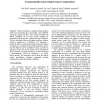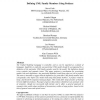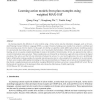1750 search results - page 211 / 350 » Formal multiple-bernoulli models for language modeling |
SEKE
2004
Springer
15 years 3 months ago
2004
Springer
Feature modeling is a popular domain analysis method for describing the commonality and variability among the domain products. The current formalisms of feature modelling do not ha...
TOOLS
1999
IEEE
15 years 2 months ago
1999
IEEE
The Unified Modeling Language is extensible, and so can be regarded as a family of languages. Implicitly or explicitly, any particular UML model should be accompanied by a definit...
SIGSOFT
2003
ACM
15 years 10 months ago
2003
ACM
State machine based formalisms such as labelled transition systems (LTS) are generally assumed to be complete descriptions m behaviour at some level of abstraction: if a labelled ...
SIGIR
2005
ACM
15 years 3 months ago
2005
ACM
This paper explores probabilistic lexico-syntactic pattern matching, also known as soft pattern matching. While previous methods in soft pattern matching are ad hoc in computing t...
AI
2007
Springer
14 years 10 months ago
2007
Springer
AI planning requires the definition of action models using a formal action and plan description language, such as the standard Planning Domain Definition Language (PDDL), as inp...



